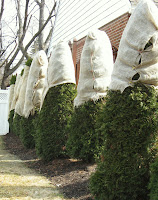

 Garden Rant of the Year
Garden Rant of the YearI will never understand why anyone would bag their leaves in fall and bring it to the curb - instead of composting them... or why wrap your shrubs for winter or neglect plants at groceries and builter supply stores?
BAGGED LEAVES"Reduce, Reuse, and Recycle" also applies to gardening.
Go for a walk into any forest and reach down or kick the dry leaves to one side and notice dead leaves underneath, push them aside and notice decomposed leaves under the dry leaves push those to one side and notice a rich black earth yielding an abundance of nutrients to the forest ecosystem. Imagine this soil in your garden?
Your plants will grow like crazy! Leaves decompose relatively quickly pile leaves onto your garden in the fall thickly and by spring they will be nothing but a a thin layer of decomposed leaves which need to be turned into the soil.
Repeating this year after year will make your soil richer than before just like the soil in old growth forests.
What waste it is to just rake up one of nature’s best to be burned later when you can put it to use in your garden.
WRAPPED SHRUBS - SOOOOO UGLY The "gardening industry" and so-called "landscapers" seems to have found a new method of cash-grab for the slow winter season: Sell as much burlap, styropur cones and twine as possible! They will tell potential customers if they don't wrap their shrubs they will be injured and die in winter. What a nonsens!
Have you ever seen a wrapped shrub in the wild? Did your grand parents wrap their bushes and shrubs for the winter? For sure not...
If you are choosing plants for your garden according to the zone in which you live, you do not need to protect your shrubs, and even if you loose a branch or two in an ice storm - so be it! It's all nature. Why do we try to play God?
What you CAN do is to mulch around tree trunks and shrubs and water them very well before heavy frost sets in.
That's all.
WHY LET THEM DIE?Plants at grocery stores, building suppliers and the like: We all know not to ever expect much from the grocery store plants, as they're usually completely neglected, baking on hot tarmag, dry and limp looking if not half (or totally) dead.
But I am asking why are they selling plants at all, if they do not care for them. It makes me really mad to see those poor flowers and plants dying, and I ask for a supervisor and tell them what I think about their neglectence.
Sometimes they admit it and give orders to water the plants. One can only guess their mark-up if they can afford to let the plants die. Even worse: I often heard they will return them to the growers.
We should neglect these reckless sellers too and buy only at nurseries that take care of the plants - which benefits later in your garden.




















































